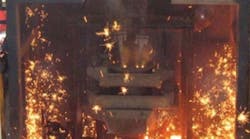Sketch showing the PRV system, including nitrogen pressurizing with straight siphons, and a vertical inductor with the pump cleaning system.
Pointing to expanding global demand for ductile iron castings, Fomet Srl has adapted a pouring furnace design — its vertical channel furnace, with an inductor flanged to the bottom of the furnace body — for foundries specializing in those cast products.
For ductile iron foundries, high productivity is a primary concern, and it’s the main reason that foundries of all sizes have adopted automatic pouring systems for their molding lines. Fomet specializes at designing pouring furnaces, having installed several hundred furnaces equipped with automatic pressure pouring systems with stopper-rod control for gray iron, malleable iron, and other specialty cast irons. Its systems have simplified pouring not only for new molding lines but also as retrofits for existing molding lines.
To develop its new pressure-pouring furnace (PRV) furnace, Fomet drew upon its own experience, making specific research into this field and verifying results in co-operation with existing clients and metallurgical technicians. The PRV is a vertical channel furnace with an inductor flanged to the bottom of the furnace body. A cover to seal the furnace vessel is equipped with a small hatch so that the furnace can be de-slagged, and also allows the inductor to be rodded, as necessary.
The furnace is designed to operate with an inert gas (like nitrogen) to pressurize it and to seal its cover, gas-tight. A substantial refractory lining makes a supporting face for the cover-sealing ring, particularly as pressure sealing is one of the known problems in coreless furnaces. It is equipped with flanged fill and pour siphons, which are easy to exchange and simple to maintain.
Unlike coreless pressure-pouring units, wherein the useful power varies according to the metal-level height relative to the induction coil, the PRV’s full super-heating capability (useful power) is always available, whether the furnace is full or holding a minimum heel.
Also, the PRV inductor power is managed so as to minimize build-up inside the channel. Inductor power availability can be by monitored by programming the inductor efficiency indicator (cos phi operating range).
The fill and pour siphons are simple to clean because they are straight, with no bottom-bend angle at the entry point to the furnace vessel. It’s even possible to change the siphons with metal inside the furnace, according to Fomet.
The developer noted that one advantage of its PRV induction channel furnace versus coreless pouring furnaces is electrical and thermal efficiency, and hence the low overall energy consumption in continuous operation.
The PRV induction coil air-cooling system minimizes thermal losses, to promote energy savings. Other furnace types require greater power inputs to maintain and superheat the metal, but it is difficult for them to control metal temperature and refractory lining life, which requires on-going maintenance, among other inherent problems.
A photomicrograph shows the rounded shapes of graphite nodules at 100X, typical of ductile iron.
In ductile iron production, treatment methods that use pure magnesium are generally recommended. According to customer data, the gas atmosphere has no initial effect on the rate of alloy fade (Mg fade.) However, after stabilization, the rate of melting loss (fade) is reduced considerably, thus ensuring that the molten metal remains ready for pouring with a sufficient Mg content over the full holding time of up to 8 hours.
Maintenance operations are simple, and kept to minimal requirements in to order maintain furnace efficiency. Having no water-cooling circuits is a design and cost advantage in this case.
Fomet’s PRV pouring furnace can be equipped with all standard options, like laser monitoring to control the metal level in the pouring channel; a CCD Vision system to control the mold cup filling level; late metalstream inoculation, furnace weighing; and an automatic skip charger for the furnace charging ladle.
If necessary, a furnace automatic nozzle centering system for the pouring cup is available, and may be necessary in vertical flask-less molding lines.









